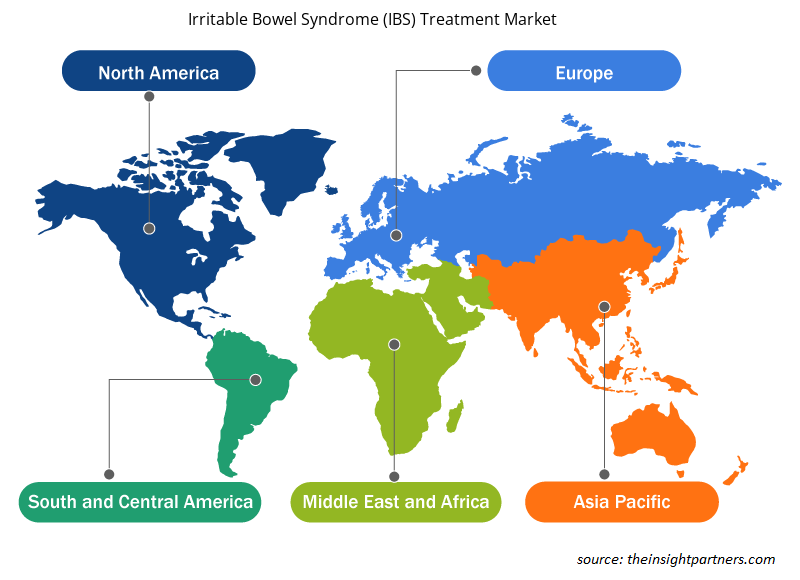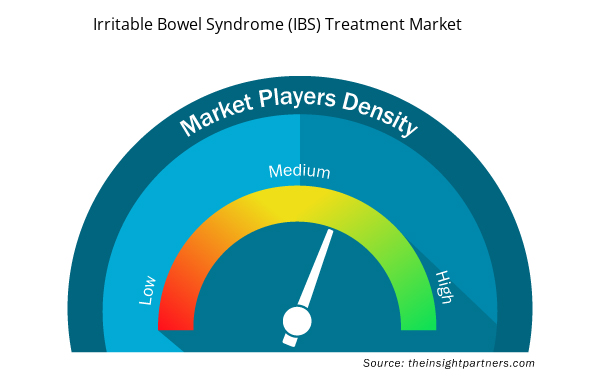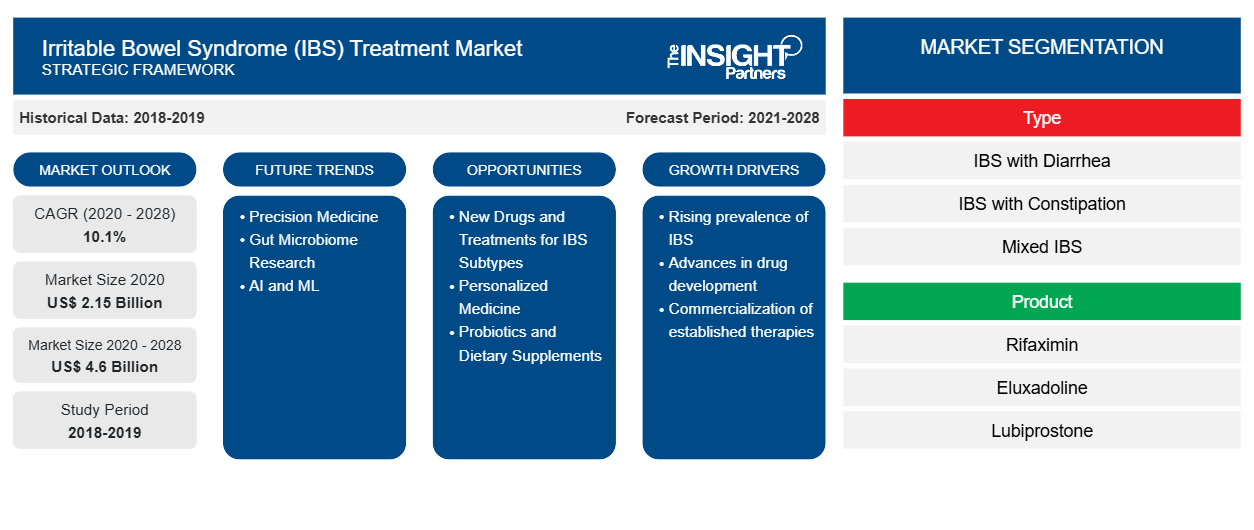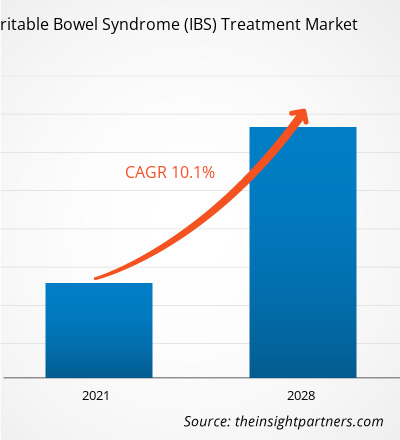過敏性腸症候群(IBS)治療市場は2020年に21億5,389万米ドルと評価され、2028年までに46億30万米ドルに達すると予測されており、 2021年から2028年にかけて10.1%のCAGRで成長すると予想されています。
過敏性腸症候群の罹患率の増加や研究開発活動の増加などの主な要因が、市場の成長を牽引しています。しかし、製品の入手可能性の限界と治療の非効率性が市場の成長を抑制しています。IBSは、腹部臓器である大腸に影響を及ぼす一般的な慢性疾患です。痙攣性結腸、粘液性大腸炎、過敏性結腸、痙攣性大腸炎とも呼ばれます。この症状は炎症性腸疾患とは大きく異なります。痙攣、腹痛、膨満感、ガス、下痢または便秘、またはその両方などの症状が現れます。症状が軽度であれば、ストレス、ライフスタイル、食生活を変えることで管理できます。一方、重度の症状は投薬とカウンセリングで治療されます。
アジア太平洋地域では、COVID-19を引き起こす新型コロナウイルスの拡散を阻止するために多くの対策が実施されています。これらの対策により、医療業界を含むさまざまな業界の多くの企業の業務が混乱しています。スタッフの隔離、サプライチェーンの障害、需要の減少により、企業は深刻な問題に直面しています。また、民間の病院チェーンでは入院患者と外来患者の治療が大幅に減少しています。医療システムの負担を軽減するため、多くの診療所が重要でない予約を延期しています。この状況により、過敏性腸症候群(IBS)治療の成長が妨げられています。
要件に合わせてレポートをカスタマイズする
このレポートの一部、国レベルの分析、Excelデータパックなど、あらゆるレポートを無料でカスタマイズできます。また、スタートアップや大学向けのお得なオファーや割引もご利用いただけます。
- このレポートの主要な市場動向を入手してください。この無料サンプルには、市場動向から見積もりや予測に至るまでのデータ分析が含まれます。
市場分析
過敏性腸症候群および関連疾患の罹患率の増加
過敏性腸症候群は、排便習慣の乱れや腹痛が原因で起こる、主にみられる慢性の胃腸疾患です。この疾患は痙攣性結腸、過敏性結腸、粘液性大腸炎、痙攣性大腸炎とも呼ばれます。過敏性腸症候群は、腹痛、便秘、下痢、けいれんなどの症状を示します。地域全体の医療システムでは、過敏性腸症候群の発症率が著しく増加しています。国際消化器疾患財団が発表したデータによると、すべてのIBS患者のうち、約 40% が軽度のIBS、約 35% が中等度のIBS、推定 25% が重度のIBSを患っています。IBSの症状に気付いていない人は多くいます。
食物アレルギー、胃腸炎の進行段階、結腸の散発的な動き、結腸内のセロトニンの異常な組成、軽度のセリアック病などの特定の要因は、 IBSを引き起こす可能性のあるリスク要因です。これらの要因により、世界中でIBSの有病率が加速すると予測されています。たとえば、2018年にNCBIで発表された研究によると、IBSは毎年米国の人口の約10%から16%に影響を与えると推定されています。このようなIBSの驚異的な有病率は、予測期間中に過敏性腸症候群(IBS )治療市場を後押しする可能性があります。
タイプベースの洞察
タイプに基づいて、過敏性腸症候群(IBS)治療市場は、混合IBS(IBS-M)、下痢を伴うIBS ( IBS-D)、および便秘を伴うIBS ( IBS-C)に分類されます。 2020年には、混合IBS(IBS-M)セグメントが市場で最大のシェアを占めました。 また、同じセグメントは、予測期間中に最高のCAGRを記録すると予想されています。 女性と男性の間でIBSの有病率が上昇していることから、便秘と下痢の複合症状を治療できる医薬品の需要が高まると予想されます。 IBSの有病率は高齢化人口で高くなっています。 したがって、混合IBSを治療するための医薬品の需要は、予測期間中に大幅に増加する可能性があります。
製品ベースの洞察
製品に基づいて、過敏性腸症候群(IBS)治療市場は、リファキシミン、エルクサドリン、ルビプロストン、リナクロチド、その他に分類されます。リナクロチドセグメントは、2020年に市場で最大のシェアを占めました。また、同じセグメントは、予測期間中に市場で最高のCAGRを記録すると予測されています。このセグメントの市場成長は、リナクロチドのジェネリック版の製造の増加や、IBS治療用のリナクロチドの開発と商品化に向けた市場統合の増加などの要因に起因しています。
流通チャネルに基づく洞察
流通チャネルに基づいて、過敏性腸症候群(IBS)治療市場は、病院薬局、ドラッグストアおよび小売薬局、オンライン薬局に分類されます。2020年には、病院薬局セグメントが市場で最大のシェアを占めました。ただし、ドラッグストアおよび小売薬局セグメントは、予測期間中に最高のCAGRを記録すると予想されます。
過敏性腸症候群 (IBS) 治療市場で事業を展開する企業は、世界中で変化する顧客の需要を満たすために製品イノベーション戦略を採用しており、これにより世界市場で自社のブランド名を維持することも可能になっています。
過敏性腸症候群治療市場レポートの範囲
過敏性腸症候群(IBS)治療市場の地域別洞察
予測期間を通じて過敏性腸症候群 (IBS) 治療市場に影響を与える地域的な傾向と要因は、Insight Partners のアナリストによって徹底的に説明されています。このセクションでは、過敏性腸症候群 (IBS) 治療市場のセグメントと、北米、ヨーロッパ、アジア太平洋、中東およびアフリカ、南米および中米の地域についても説明します。

- 過敏性腸症候群(IBS)治療市場の地域別データを入手
過敏性腸症候群(IBS)治療市場レポートの範囲
| レポート属性 | 詳細 |
|---|---|
| 2020年の市場規模 | 21.5億米ドル |
| 2028年までの市場規模 | 46億米ドル |
| 世界のCAGR(2020年 - 2028年) | 10.1% |
| 履歴データ | 2018-2019 |
| 予測期間 | 2021-2028 |
| 対象セグメント | タイプ別
|
| 対象地域と国 | 北米
|
| 市場リーダーと主要企業プロフィール |
|
市場プレーヤーの密度:ビジネスダイナミクスへの影響を理解する
過敏性腸症候群 (IBS) 治療市場は、消費者の嗜好の変化、技術の進歩、製品の利点に対する認識の高まりなどの要因により、エンドユーザーの需要が高まり、急速に成長しています。需要が高まるにつれて、企業は提供を拡大し、消費者のニーズを満たすために革新し、新たなトレンドを活用し、市場の成長をさらに促進しています。
市場プレーヤー密度とは、特定の市場または業界内で活動している企業または会社の分布を指します。これは、特定の市場スペースに、その規模または総市場価値と比較して、どれだけの競合相手 (市場プレーヤー) が存在するかを示します。
過敏性腸症候群(IBS)治療市場で事業を展開している主要企業は次のとおりです。
- アイアンウッドファーマシューティカルズ社
- アッヴィ。
- セベラ製薬株式会社
- 武田薬品工業株式会社
- アルファシグマ SpA
免責事項:上記の企業は、特定の順序でランク付けされていません。

- 過敏性腸症候群(IBS)治療市場のトップキープレーヤーの概要を入手
過敏性腸症候群(IBS)治療市場 – タイプ別
- 下痢を伴うIBS(IBS-D)
- 便秘を伴うIBS(IBS-C)
- 混合型IBS(IBS-M)
過敏性腸症候群(IBS)治療市場 – 製品別
- リファキシミン
- エルクサドリン
- リナクロチド
- ルビプロストン
- その他
過敏性腸症候群(IBS)治療市場 – 流通チャネル別
- 病院 薬局
- ドラッグストアと薬局
- オンライン薬局
過敏性腸症候群(IBS)治療市場 – 地域別
北米
- 私たち
- カナダ
- メキシコ
ヨーロッパ
- フランス
- ドイツ
- イタリア
- 英国
- スペイン
- その他のヨーロッパ
アジア太平洋(APAC)
- 中国
- インド
- 韓国
- 日本
- オーストラリア
- その他のアジア太平洋地域
中東およびアフリカ(MEA)
- 南アフリカ
- サウジアラビア
- アラブ首長国連邦
- MEAの残り
南米と中米(詐欺)
- ブラジル
- アルゼンチン
- 残りの詐欺
企業プロフィール
- アイアンウッドファーマシューティカルズ社
- アッヴィ。
- セベラ製薬株式会社
- 武田薬品工業株式会社
- アルファシグマ SpA
- アステラス製薬株式会社
- アストラゼネカ
- シンセティックバイオロジクス社
- ボシュロム株式会社
- ラネットカンパニー
- 過去2年間の分析、基準年、CAGRによる予測(7年間)
- PEST分析とSWOT分析
- 市場規模価値/数量 - 世界、地域、国
- 業界と競争環境
- Excel データセット


- Aircraft Wire and Cable Market
- Batter and Breader Premixes Market
- Volumetric Video Market
- Pipe Relining Market
- Photo Editing Software Market
- Transdermal Drug Delivery System Market
- Integrated Platform Management System Market
- Customer Care BPO Market
- Small Molecule Drug Discovery Market
- Sexual Wellness Market

Report Coverage
Revenue forecast, Company Analysis, Industry landscape, Growth factors, and Trends

Segment Covered
This text is related
to segments covered.

Regional Scope
North America, Europe, Asia Pacific, Middle East & Africa, South & Central America

Country Scope
This text is related
to country scope.
よくある質問
The irritable bowel syndrome (IBS) treatment market majorly consists of the players such as Ironwood Pharmaceuticals, Inc., AbbVie., Sebela Pharmaceuticals, Inc., Takeda Pharmaceutical Company Limited, Alfasigma S.p.A., Astellas Pharma Inc., AstraZeneca, Synthetic Biologics, Inc., Bausch + Lomb Incorporated and Lannett Company Inc amongst others.
The factors that are driving growth of the market are increasing prevalence of irritable bowel syndrome diseases and increasing research & development activities.
Irritable bowel syndrome (IBS) is a common disorder that affects the abdominal organ, large intestine. It is also known as spastic colon, mucous colitis, irritable colon, and spastic colitis. The condition is much different than inflammatory bowel disease. However, it is a chronic condition which a person must manage for a longer period. It shows symptoms such as cramping, abdominal pain, bloating, gas, and diarrhea or constipation, or both at the same. These symptoms can be managed by changing stress, lifestyle, and diet. And the more severe symptoms are treated with medication and counseling.
Trends and growth analysis reports related to Life Sciences : READ MORE..
The List of Companies - Irritable Bowel Syndrome (IBS) Treatment Market
- Ironwood Pharmaceuticals, Inc.
- AbbVie.
- Sebela Pharmaceuticals, Inc.
- Takeda Pharmaceutical Company Limited
- Alfasigma S.p.A.
- Astellas Pharma Inc.
- AstraZeneca
- Synthetic Biologics, Inc.
- Bausch + Lomb Incorporated
- Lannett Company Inc
The Insight Partners performs research in 4 major stages: Data Collection & Secondary Research, Primary Research, Data Analysis and Data Triangulation & Final Review.
- Data Collection and Secondary Research:
As a market research and consulting firm operating from a decade, we have published and advised several client across the globe. First step for any study will start with an assessment of currently available data and insights from existing reports. Further, historical and current market information is collected from Investor Presentations, Annual Reports, SEC Filings, etc., and other information related to company’s performance and market positioning are gathered from Paid Databases (Factiva, Hoovers, and Reuters) and various other publications available in public domain.
Several associations trade associates, technical forums, institutes, societies and organization are accessed to gain technical as well as market related insights through their publications such as research papers, blogs and press releases related to the studies are referred to get cues about the market. Further, white papers, journals, magazines, and other news articles published in last 3 years are scrutinized and analyzed to understand the current market trends.
- Primary Research:
The primarily interview analysis comprise of data obtained from industry participants interview and answers to survey questions gathered by in-house primary team.
For primary research, interviews are conducted with industry experts/CEOs/Marketing Managers/VPs/Subject Matter Experts from both demand and supply side to get a 360-degree view of the market. The primary team conducts several interviews based on the complexity of the markets to understand the various market trends and dynamics which makes research more credible and precise.
A typical research interview fulfils the following functions:
- Provides first-hand information on the market size, market trends, growth trends, competitive landscape, and outlook
- Validates and strengthens in-house secondary research findings
- Develops the analysis team’s expertise and market understanding
Primary research involves email interactions and telephone interviews for each market, category, segment, and sub-segment across geographies. The participants who typically take part in such a process include, but are not limited to:
- Industry participants: VPs, business development managers, market intelligence managers and national sales managers
- Outside experts: Valuation experts, research analysts and key opinion leaders specializing in the electronics and semiconductor industry.
Below is the breakup of our primary respondents by company, designation, and region:

Once we receive the confirmation from primary research sources or primary respondents, we finalize the base year market estimation and forecast the data as per the macroeconomic and microeconomic factors assessed during data collection.
- Data Analysis:
Once data is validated through both secondary as well as primary respondents, we finalize the market estimations by hypothesis formulation and factor analysis at regional and country level.
- Macro-Economic Factor Analysis:
We analyse macroeconomic indicators such the gross domestic product (GDP), increase in the demand for goods and services across industries, technological advancement, regional economic growth, governmental policies, the influence of COVID-19, PEST analysis, and other aspects. This analysis aids in setting benchmarks for various nations/regions and approximating market splits. Additionally, the general trend of the aforementioned components aid in determining the market's development possibilities.
- Country Level Data:
Various factors that are especially aligned to the country are taken into account to determine the market size for a certain area and country, including the presence of vendors, such as headquarters and offices, the country's GDP, demand patterns, and industry growth. To comprehend the market dynamics for the nation, a number of growth variables, inhibitors, application areas, and current market trends are researched. The aforementioned elements aid in determining the country's overall market's growth potential.
- Company Profile:
The “Table of Contents” is formulated by listing and analyzing more than 25 - 30 companies operating in the market ecosystem across geographies. However, we profile only 10 companies as a standard practice in our syndicate reports. These 10 companies comprise leading, emerging, and regional players. Nonetheless, our analysis is not restricted to the 10 listed companies, we also analyze other companies present in the market to develop a holistic view and understand the prevailing trends. The “Company Profiles” section in the report covers key facts, business description, products & services, financial information, SWOT analysis, and key developments. The financial information presented is extracted from the annual reports and official documents of the publicly listed companies. Upon collecting the information for the sections of respective companies, we verify them via various primary sources and then compile the data in respective company profiles. The company level information helps us in deriving the base number as well as in forecasting the market size.
- Developing Base Number:
Aggregation of sales statistics (2020-2022) and macro-economic factor, and other secondary and primary research insights are utilized to arrive at base number and related market shares for 2022. The data gaps are identified in this step and relevant market data is analyzed, collected from paid primary interviews or databases. On finalizing the base year market size, forecasts are developed on the basis of macro-economic, industry and market growth factors and company level analysis.
- Data Triangulation and Final Review:
The market findings and base year market size calculations are validated from supply as well as demand side. Demand side validations are based on macro-economic factor analysis and benchmarks for respective regions and countries. In case of supply side validations, revenues of major companies are estimated (in case not available) based on industry benchmark, approximate number of employees, product portfolio, and primary interviews revenues are gathered. Further revenue from target product/service segment is assessed to avoid overshooting of market statistics. In case of heavy deviations between supply and demand side values, all thes steps are repeated to achieve synchronization.
We follow an iterative model, wherein we share our research findings with Subject Matter Experts (SME’s) and Key Opinion Leaders (KOLs) until consensus view of the market is not formulated – this model negates any drastic deviation in the opinions of experts. Only validated and universally acceptable research findings are quoted in our reports.
We have important check points that we use to validate our research findings – which we call – data triangulation, where we validate the information, we generate from secondary sources with primary interviews and then we re-validate with our internal data bases and Subject matter experts. This comprehensive model enables us to deliver high quality, reliable data in shortest possible time.


 このレポートの無料サンプルを入手する
このレポートの無料サンプルを入手する